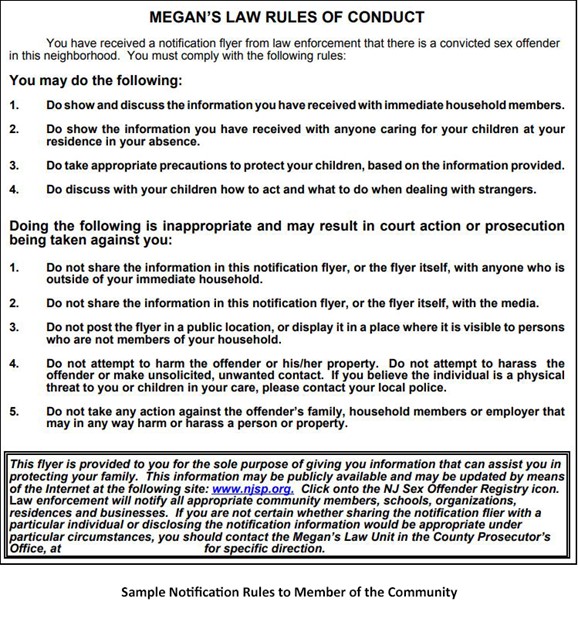Factors that Matter in Applications for Relief from Megan’s Law Registration, Community Notification, and Supervision

Our laws specifically provide for and envision that a Megan’s Law Registrant may be discharged from registration, community notification, and Community/Parole Supervision for Life upon a finding that the Registrant is “not likely to pose a threat to the safety of others.” This legal blog post explores the steps Megan’s Law Registrants must take to demonstrate to the court that they have met this standard.
1. Is the Registrant eligible under the statute?
The first hurdle concerns determining eligibility under the statute and determining whether the Registrant’s conviction is an eligible offense. That assessment must be made with counsel upon examination of the Judgment of Conviction and related court documents. Once determined eligible for relief, the Registrant has the burden to demonstrate that he/she is a law-abiding citizen with no intervening offenses, has fully complied with supervision requirements, and that more than 15 years have passed since the conviction or release from prison.
2. Can the Registrant make a compelling case for relief?

In filing an application for relief to the court, one should evaluate a number of issues to determine if the Registrant is likely to present a compelling case for relief. Some of the factors that should be evaluated and considered include:
- Whether the Registrant’s conviction falls within the crimes eligible for relief;
- Whether more than 15 years have passed without any additional offenses;
- Whether the Registrant has a stable residence;
- Whether the Registrant has a history of steady and appropriate employment;
- Whether the Registrant has a history of stable social and family relationships;
- Whether the Registrant has fully complied with and completed any counseling;
- Whether the Registrant has recently been evaluated by a qualified mental health professional who has performed a psychosexual evaluation/risk assessment;
- The Registrant’s designated “Tier” level and whether the Registrant has been determined to fall within a Tier One level for registration and notification purposes;
- Whether the Registrant has demonstrated insight into the underlying crime;
- Whether the Judgment of Conviction, the presentence report or sentencing transcript contains information that supports an argument that the Registrant is not a threat to society;
- Whether the court determined that the Registrant was a repetitive compulsive offender at the time of sentencing;
- If there was a determination of repetitive and compulsive behavior then one should provide evidence that the Registrant’s entire life subsequent to the conviction or release from prison demonstrates that the Registrant does not present a risk to the safety of any member of society;
- Whether any health conditions support a finding that the Registrant no longer presents a risk (or presents a lesser risk) of re-offense;
- The Registrant’s age at the time of the offense;
- The Registrant’s age at the time of the application;
- If a sex offense occurred at a young age an argument can be made that the offense was a product of immaturity that has decreases or ceased with the passage of time;
- Youth, at the time of offense, may be advanced as a mitigating factor given the fact that adolescent minds are not fully developed. It is recognized that adolescents engage in risky behavior, and they are less prone to take into consideration the consequences of their actions;
- If the Registrant is over 60 years old an argument may be made that advancing age reduces the risk of recidivism, simply by virtue of maturity and improved self-control;
- There are professional studies that confirm that recidivism, as one grows older, dramatically decreases;
- These studies also statistically confirm that recidivism rates decrease with age and that by the age of 60 recidivism rates drop dramatically;
- Such statistical data may be advanced to argue that the older a Registrant is, the less likely the Registrant is to engage in risky behavior, criminal behavior, or improper sexual behavior.
3. Determining the likelihood of success.
While some of the factors listed above may not be available to support the motion, the factors should be evaluated to determine how best to argue that the registration, notification, and/or supervision provisions imposed under Megan’s Law are no longer necessary to protect the public from the petitioning Registrant.
If you have a question about this legal blog alert or a question about a Megan’s Law Registrant’s eligibility to file an application to be discharged from registration, community notification, and supervision, please contact Eric Marcy, Esq., at Lyons & Associates, P.C. at 908-575-9777 (office) or 908-581-2388 (cell) or by email at [email protected].
Our criminal defense and Megan’s Law lawyers at Lyons & Associates, P.C. will vigorously defend you as you go through the criminal justice system. Call us at 908-575-9777 or contact us online today to schedule a free consultation. We have offices located in Somerville and Morristown, New Jersey, and represent clients throughout New Jersey including, but not limited to, clients throughout Somerset County, Morris County, Middlesex County, Union County, Essex County, Bergen County, Hunterdon County, Warren County, Sussex County, Passaic County, and Monmouth County.
References:
N.J.S.A. 2C:7-2.
Miller v. Alabama, 567 U.S. 460, 471-472 (2012).
Roper v. Simmons, 543 U.S. 551, 570 (2005).
Attorney General Guidelines for Law Enforcement for the Implementation of Sex Offender Registration and Community Notification Law, June 1998, Revised February 2007.
U.S. Department of Health & Human Services, OAPP Module Adolescent Brain Development (including modules on: What is Adolescence? Maturation of the Prefrontal Cortex, Understanding Adolescent Risk-Taking, and Risk Perception).
Peer Influences; Steinberg & Scott, “Less Guilty by Reason of Adolescence: Developmental Immaturity, Diminished Responsibility, and the Juvenile Death Penalty,” 58 Am. Psychologist 1009, 1014 (2003).
Arnett, “Reckless Behavior in Adolescence: A Developmental Perspective,” 12 Developmental Review 339 (1992).
Attorney General Guidelines for Law Enforcement for the Implementation of Sex Offender Registration and Community Notification Law, June 1998, Revised February 2007.
H.E. Barbaree, R. Blanchard & C.M. Langston, “The Development of Sexual Aggression Through the Life Span,” 989 Annals of the N.Y. Acad. Sci. 59-71 (2003).
S. Frazel, G. Jostedt, N. Langstrom & M. Grann, Risk Factors for Criminal Recidivism in Older Sexual Offenders, 18 (2) Sexual Abuse 159-67 (2006).
D. Thornton, “Age and Sexual Recidivism: A Variable Connection,” 18(2) Sexual Abuse 123-135 (2006).
A.C. Kinsey, W.B. Pomeroy & C.E. Martin, Sexual Behavior in the Human Male (1948).
L.A. Panser, T. Rhodes, C.J. Girman, H.A. Guess, C.G. Chiute & J.E. Osterling, “Sexual Functioning of Men Ages 40 to 79 Years: The Olmsted County Study of Urinary, Symptoms and Health Status Among Men,” 43 J. Am. Geriatrics Society 1107-1111 (1995).
D.F. Trocki, “Patterns of Sexuality and Risky Sexuality in the General Population of a California County,” 29 J. Sex Research 85-94 (1992).
H.A. Feldman, I. Goldstein, D.G. Hatzichristou, R.J. Drane & J.B. McKinlay, “Impotence and Its Medical and Psychosocial Correlates: Results of the Massachusetts Male Aging Study,” 151(1) J. Urology 54-61 (1994).


